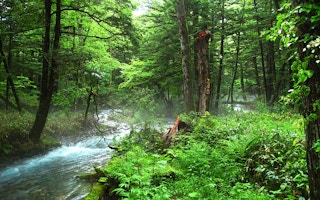By analysing the composition of sounds in a forest — called a soundscape — scientists can make cost-effective and reliable assessment of the forest, according to a new study conducted in Papua New Guinea (PNG).
A soundscape’s saturation refers to the variety of pitches, or frequencies, found in the sounds. The study, published in Conservation Biology on 14 June, confirmed that land-use zones with intact forest cover had significantly higher soundscape saturation.
Autonomous recorders set up at 34 locations in the Adelbert Mountains of PNG covered sites ranging from pristine forests to small cacao farms. Led by Zuzana Burivalova, tropical forest ecologist at Princeton University, the study recorded almost 1,300 hours of sounds in July 2015.
“
This study is a proof-of-concept that shows we can acquire a lot of high-quality acoustic data in tropical rainforests and that soundscape saturation is a relatively simple measurement that tells us a lot about the environment.
Zuzana Burivalova, Princeton University
Burivalova and her team found that soundscape saturation peaked at dawn and dusk, likely because most birds and amphibians vocalise then. Sites with less forest cover due to human activity (e.g., farming) have less saturated soundscapes versus those with high forest cover (e.g., conservation and hunting zones).
“This study is a proof-of-concept that shows we can acquire a lot of high-quality acoustic data in tropical rainforests and that soundscape saturation is a relatively simple measurement that tells us a lot about the environment,” Burivalova tells SciDev.Net.
Sound recorders make great tools for environmental assessment because they can be deployed in remote places and work autonomously for long periods. The ease of collecting data in many places at the same time would allow scientists to study human impact on tropical forests over large spatial scales, says Burivalova.
Furthermore, the soundscape data is a permanent record of the sounds of a specific place and time. The recorded soundscape serves as a baseline to compare against future environmental changes. Future researchers can reanalyse the records with new technology or new questions.
But soundscape analysis of terrestrial ecosystems is still a fledgling field. Analysis remains the biggest challenge. “In the last five years there has been an explosion of different ways to measure and analyse soundscape data,” says Burivalova, describing the situation as typical of any new field.
Soundscape studies are biased towards animals that vocalise, but biases are inherent in every environmental survey method, says Jessica Deichmann, a biologist at the Smithsonian Conservation Biology Institute who has analysed soundscapes of Peruvian rainforests to document the impact of gas mining.
“Soundscape ecology will be a huge tool for future documentation and evaluation of human impact,” says Deichmann. “This study is a great example of how you can use sound to do that.”
This piece was produced by SciDev.Net’s Asia & Pacific desk.










